22.11.2024 by Infogram
Imagine, you need to create an email marketing campaign for your audience, optimize an article according to the best SEO practices, or create insightful charts for your next sales performance meeting that’s happening in an hour. Wouldn’t it be great if there would be tools that can help with tackling these tasks, saving you time and reducing error possibility? That’s where AI tools for business come in, helping you manage tasks and reach business goals more efficiently!
Artificial Intelligence (AI) is transforming the business landscape, offering a wide range of tools to boost productivity, optimize decision-making, and create a building ground for innovation. By using the power of AI, companies can streamline complex operations, improve efficiency, and provide highly personalized experiences that meet and exceed customer expectations.
Ultimately, AI empowers businesses of all sizes to operate more effectively, allowing teams to focus on strategic tasks while leaving routine work to automated solutions. With AI becoming more accessible, organizations can improve competitiveness and fuel growth in an increasingly digital world.

Consequently, in this article, we’re going to explore what are the best AI tools for business. From managing tasks to analyzing data and creating presentations and data visualizations – we’ll cover it all. Read on to discover the best tools for business in 2025.
How to choose the right AI business tool?
Choosing the right business tools is crucial. The tools you use can greatly impact your understanding of business processes, your workflow, workload, productivity, and overall success rate. However, choosing the right AI tool adds a layer of complexity as AI-powered technology comes with another set of considerations. Now, let’s explore the key aspects of browsing and selecting AI tools. In other words, how to choose the right AI tool?
1. Define your business objectives
Start by identifying the specific challenges or inefficiencies within your business. For example, are you looking to automate repetitive tasks, improve customer engagement or streamline content creation?
Furthermore, outline what success looks like with this tool. Define measurable goals, such as reducing workload by a specific percentage, improving lead generation, or decreasing response times.
And remember to focus on tools that directly align with your highest-priority tasks. By narrowing down use cases, you’ll make it easier to identify tools that fit your immediate needs rather than a generic solution.
2. Evaluate AI features
When picking out an AI tool, assess the core features and functionalities that the tool offers. Look for features that align with your specific use case, such as automation, predictive analytics, natural language processing, or machine learning capabilities.
It’s important to check if the tool allows customization to fit your unique workflows or branding. Many AI tools come with customizable templates or settings that allow you to adjust how the tool operates.
Also, consider whether the tool can grow with your business. Choose a tool that can handle increasing data volumes, larger teams, or additional complexity over time.
3. Assess ease of use and integration
Consider the learning curve associated with each tool. A tool that is too complex may not be adopted effectively by your team, whereas an intuitive, easy-to-use tool can be quickly integrated into daily routines.
Also, here it’s important to evaluate the level of support the tool offers for onboarding, including tutorials, support documentation, or customer service. For example, some tools offer free trials or demos, which can be valuable for assessing usability before committing.
When it comes to implementing the tool, ensure the AI tool can seamlessly integrate with other systems or platforms your business already uses. Good integration reduces friction and enables data flow across tools.

4. Examine data privacy and security
AI tools often require access to company data to perform effectively. Review each tool’s data privacy and handling policies to ensure they comply with regulations such as GDPR or HIPAA, depending on your industry.
On that point, make sure to look for tools that offer encryption, secure authentication, and other data protection measures to safeguard your business data. Choosing a tool with a strong security reputation is especially crucial if you’re dealing with sensitive customer or financial data.
5. Consider cost and return on investment (ROI)
Before committing to a tool, analyze the cost structure, including initial setup fees, monthly or annual subscription fees, and any costs for add-ons or upgrades. Some AI tools may require additional investments in hardware or software.
Furthermore, make sure to estimate how the tool could benefit your business financially. For instance, calculate potential savings from automating tasks, improving lead conversion rates, or increasing productivity. A higher ROI justifies a higher initial cost.
Also, don’t forget about the free trials! Many AI tools offer free trials or pilot programs. This is a great way to test the tool’s effectiveness without fully committing.
6. Evaluate vendor support and community resources
When starting out with a new tool, effective support is key. That’s why it’s important to look into the support options available, such as 24/7 customer service, email support, live chat, or phone support. Responsive customer service can be essential if issues arise or if your team needs technical assistance.
On that point, many AI tools have user communities, forums, and knowledge bases. These resources can be valuable for troubleshooting, getting advice from other users, or learning best practices.
Lastly, choose a tool that can ensure regular updates and feature additions. AI technology evolves rapidly, and staying current with updates can be beneficial for maintaining competitive advantage.
7. Test the tool with real use cases
If possible, run a pilot test with a small team or department to gather feedback on functionality, usability, and compatibility with existing workflows. This hands-on experience can reveal unforeseen limitations or benefits.
Later, collect input from team members using the tool. Their feedback can provide insight into usability, potential obstacles, and overall effectiveness. Positive feedback from end-users often indicates that the tool is a good fit.
8. Make a decision based on data and insights
After gathering all relevant information and testing, weigh the benefits and drawbacks of each tool. And choose a tool that not only meets current requirements but also has the flexibility to support future needs.
Once you decide on a tool, develop a detailed implementation plan, including timelines, onboarding, and training sessions. An organized rollout will ensure smooth integration and a positive user experience.

Overall, choosing the right AI tool requires careful consideration of business goals, tool features, security, and costs. Make sure to follow the aforementioned step to be equipped to select an AI tool that supports your needs and empowers your business to scale and succeed in the long term.
Now, let’s explore the best AI tools for business, starting from Infogram and Prezi to Jasper.AI and HubSpot.
AI tool for data visualization
Data visualization tools enable businesses to turn complex datasets into easy-to-understand visual formats. While there are many data visualization tools available, not all offer AI capabilities. From tools that do offer, Infogram stands out with its highly interactive charts, maps, and infographics that can truly engage any audience.
Infogram
Infogram is a powerful data visualization tool for creating compelling charts, infographics, and reports. Now, accompanied with AI-powered functionalities, creating and sharing data visualizations is made even easier.
Key features:
- AI infographic and chart maker. With Infogram’s AI, you can quickly generate stunning infographics and charts from your data with just a few clicks. The AI will automatically populate the infographic template or chart with your information or data, saving you time and effort.
- AI chart suggestions. Unsure which chart type to use? The AI chart suggester will analyze your data and recommend the most suitable chart to convey your message effectively. This feature not only saves you time and effort but also informs new ways of representing and analyzing your data.
- AI text editor: With the help of AI-powered writing assistance, you can write clear and concise text for your visualizations. The AI can assist you in summarizing or expanding your ideas for improved readability and clarity.
AI tool for presentations
Creating impactful presentations is crucial for communicating ideas and engaging audiences in the business setting. AI-powered presentation tools can offer design assistance, automatic content generation, and interactive features to create presentations that captivate and inform. While there are a number of tools that include some AI features, Prezi stands out with its creative and unique format, making it a noteworthy AI tool for businesses.
Prezi AI
Prezi elevates traditional presentations by allowing users to create visually dynamic presentations that keep audiences engaged. With its new set of AI features, creating engaging presentations is an easy, quick, and inspired process.
Key features:
- AI presentation maker. With Prezi AI, you can quickly generate professional presentations from your content or simply an idea. Just input your topic and description, and Prezi AI will automatically create a visually appealing presentation, complete with suitable color schemes, layouts, images, text, and design elements.
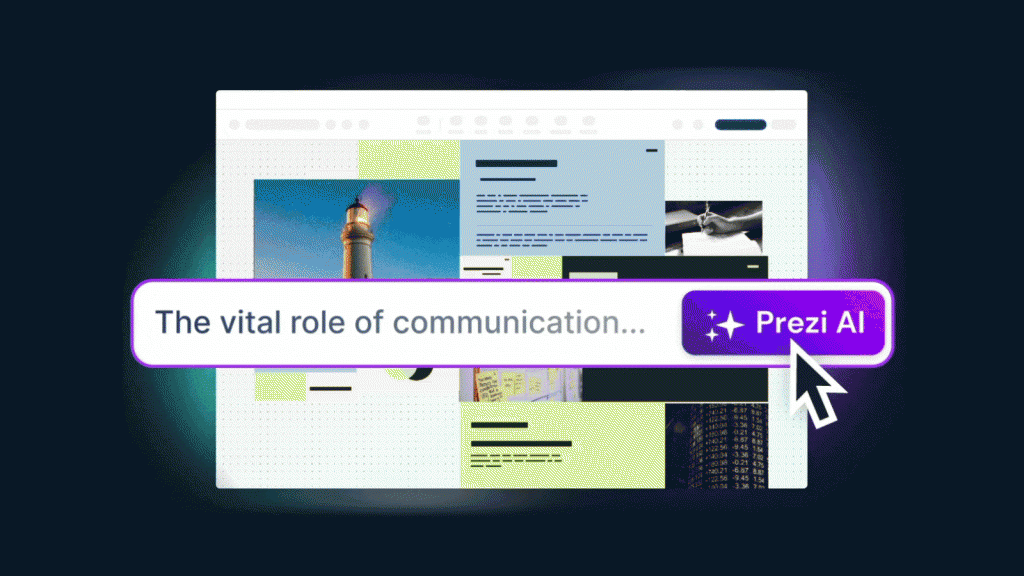
- AI-powered design suggestions. After generating a presentation, you’ll notice that you can still receive more design suggestions. The suggestions can help you with layout and visual styling, making presentations look professional without requiring design skills.
- AI text editor. Elevate your writing with AI-powered suggestions and improve clarity, conciseness, and overall impact.
- AI animated slides maker. Prezi AI also allows you to transform your bullet points from monotone lists to animated and visually appealing slides. This feature is especially useful for making your presentations more visually appealing.
AI-powered data analysis tools
AI-powered data analysis tools enable businesses to extract actionable insights from large datasets, automating the process of identifying trends, patterns, and anomalies. These tools can help you make data-driven decisions quickly and accurately, transforming data into valuable insights. Here are a few noteworthy AI tools you should consider for analyzing data.
Microsoft Power BI
Microsoft Power BI is a popular data analysis tool that combines business intelligence with AI-powered insights, making it a comprehensive solution for reporting and predictive analysis.
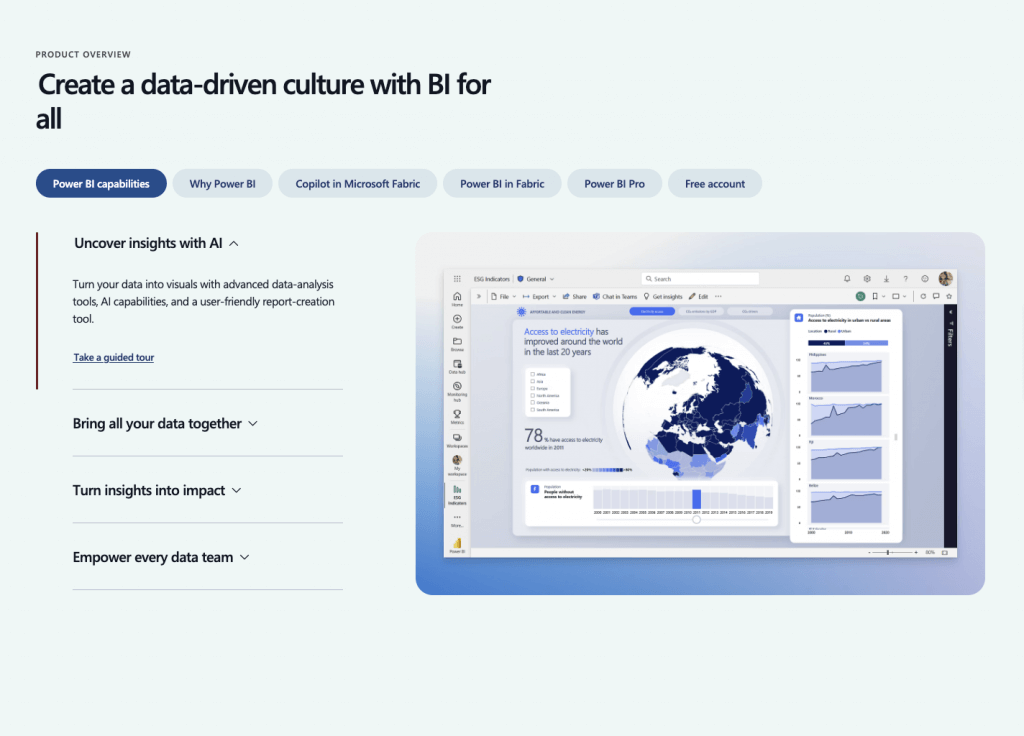
Key features:
- Quick insights. Power BI’s AI insights feature uses machine learning models to generate quick insights from complex datasets, automating the discovery of key data patterns and relationships.
- Anomaly detection and forecasting. Power BI can identify unusual trends or outliers in data, helping businesses address issues proactively. The forecasting tool uses historical data to predict future trends.
- Integration with Azure Machine Learning. For advanced use cases, Power BI can integrate with Azure Machine Learning, allowing data scientists and analysts to incorporate custom machine learning models into their reports and dashboards.
Tableau with Einstein analytics
Tableau, enhanced by Salesforce’s Einstein Analytics, is a powerful data tool that integrates AI-driven analytics for advanced data insights.
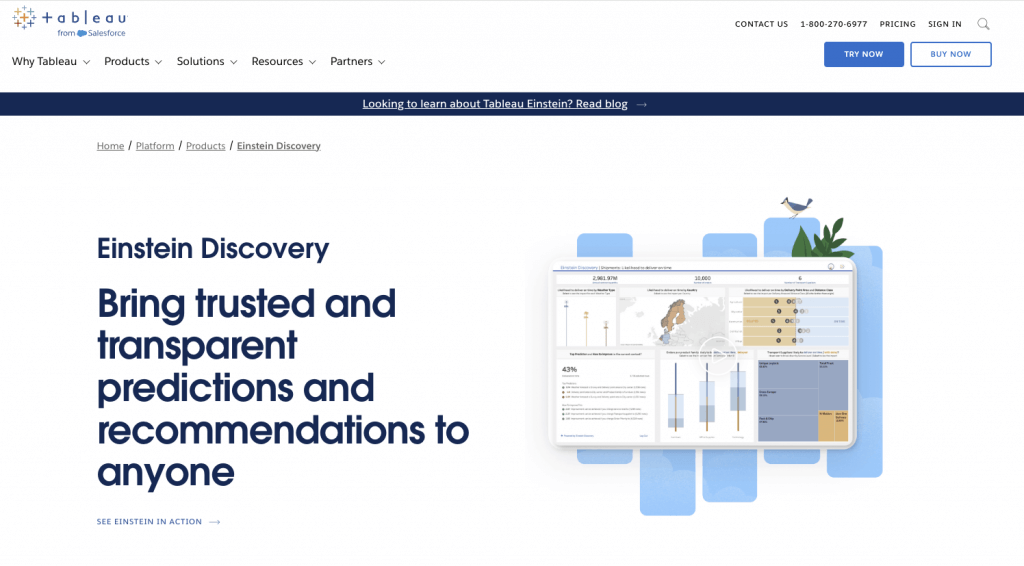
Key features:
- AI-driven predictions. Einstein Analytics leverages machine learning to provide predictive analytics directly within Tableau. Users can forecast trends, identify high-risk areas, and predict customer behavior based on historical data patterns.
- Automated data discovery. Tableau’s AI models help users discover insights by automatically identifying and highlighting relevant data correlations. This feature reduces the need for manual analysis, saving time and improving accuracy.
- Natural Language Interactions. Tableau’s “Ask Data” feature allows users to query data in natural language, making data exploration more accessible to non-technical team members. This feature enables users to receive visual answers quickly, without needing extensive knowledge of Tableau’s interface.
These AI-powered data analysis tools can help businesses make sense of their data, highlight insights, and predict future outcomes. By making use of these features, you can improve decision-making, optimize strategies, and stay ahead in a competitive market.
AI tools for project management
Project management has evolved significantly with the introduction of AI-powered tools. AI tools are revolutionizing the way we plan, organize, and execute projects, making them more efficient and effective.
If you’re looking for AI tools to boost your productivity when it comes to project management, here are a couple of tools you should consider implementing.
Asana
Asana has long been an effective project management tool, known for its intuitive task lists, timelines, and dashboards. Recently, Asana has integrated AI features designed to simplify the project management experience and empower teams to work better and smarter.
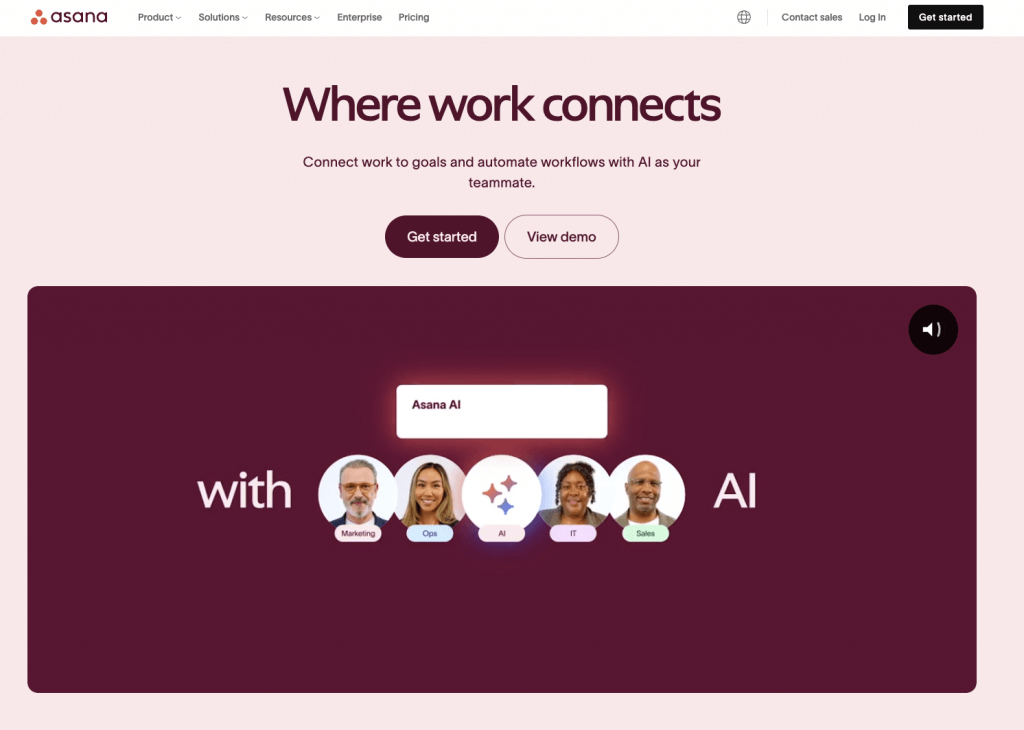
Key features:
- Prioritization recommendations. AI analyzes team workloads and task dependencies to suggest optimal task prioritization, ensuring that the most important work gets done first.
- Task automation. Automates repetitive tasks, such as creating tasks, setting deadlines, and assigning work, freeing up team members to focus on strategic initiatives.
- Workflow optimization. Identifies potential bottlenecks and suggests ways to improve workflows, leading to increased efficiency and faster project completion.
Asana’s AI tools support strategic planning by offering insights into project timelines and potential delays, helping teams stay agile in fast-moving work environments.
ClickUp
ClickUp is another powerful project management tool that has embraced AI to make project tracking, task management, and team collaboration more efficient. Known for its versatility and customizable features, ClickUp’s AI tools add value by improving productivity and simplifying complex workflows.
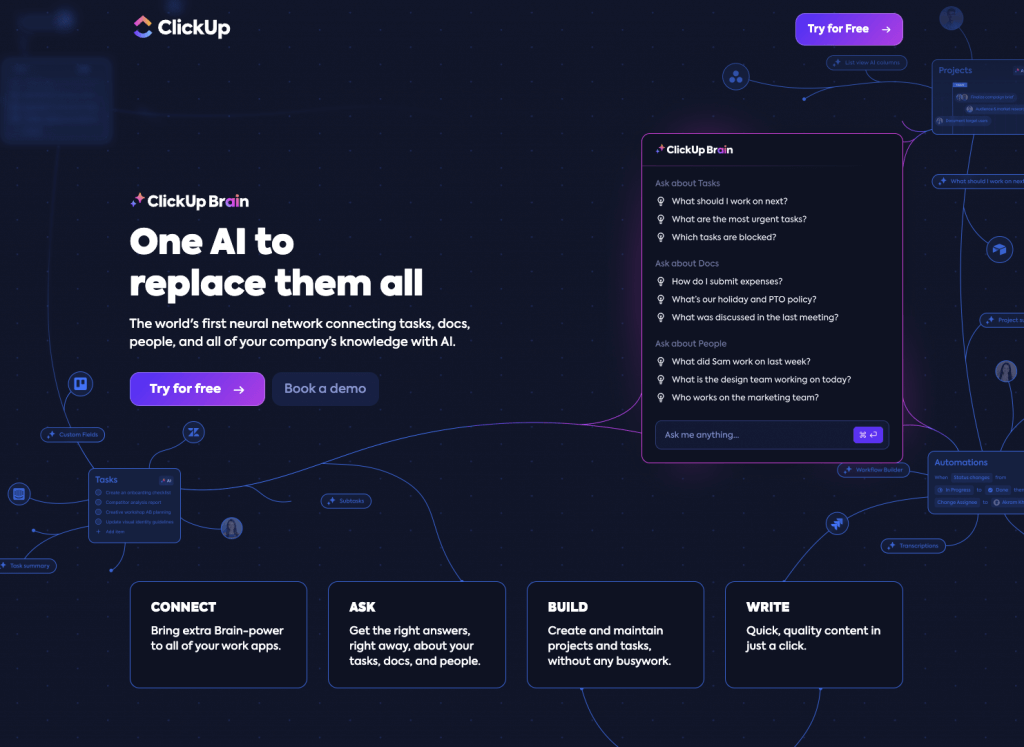
Key features:
- Catch-up on conversations. ClickUp AI provides instant recaps of lengthy comment threads and Docs, so you’re always in the loop.
- Quick summaries: ClickUp AI condenses extensive Docs like meeting notes, white papers, or research documents with a single click, helping users grasp the main ideas quickly.
- Generate action items: With ClickUp AI, it’s possible to automatically capture and assign action items from meeting notes or comments, keeping everyone on track.
- Automated task prioritization: Like Asana, ClickUp uses AI to prioritize tasks intelligently. By understanding which tasks have dependencies or are mission-critical, ClickUp can adjust priorities automatically as team needs shift.
With AI’s support, ClickUp users can benefit from fewer manual processes and a more data-driven approach to project management, resulting in a better workflow overall.
AI tools for writing
AI-powered writing assistants are transforming the way individuals and businesses create, edit, and optimize written content. These tools leverage artificial intelligence to improve grammar, style, readability, and even creativity, making it easier to produce high-quality text quickly and efficiently. Two popular AI-driven writing assistants, Grammarly and Jasper.ai, each offer distinct capabilities to support different aspects of the writing process.
Grammarly
Grammarly is a comprehensive AI-powered writing assistant that focuses on improving clarity, correctness, engagement, and delivery in writing. It’s widely used by students, professionals, and content creators to ensure that their writing is polished and error-free.

Key features:
- Summarizing & writing. Grammarly’s summarizing tool can turn complex ideas into concise summaries, perfect for simplifying dense information. The full-paragraph writing tool helps you quickly start documents by generating complete paragraphs, ideal for introductions or expanding main ideas.
- Brainstorming features. For brainstorming, Grammarly’s AI-powered idea generator empowers creativity in users by suggesting fresh angles for any writing project. Its formal letter generator ensures business and personal letters maintain the right professional tone.
- Drafting assistant. The article drafting assistant is great for overcoming writer’s block, generating initial drafts that help users start writing faster.
- Rewriting features. Grammarly also offers an AI-powered sentence rewriter and paragraph rewriter to rephrase sentences or entire sections, ensuring clarity, uniqueness, and improved readability.
- Rewording tool. The AI-driven rewording tool lets users quickly rephrase text with alternative phrasings, providing variety and avoiding repetition.
What’s more: There are many other features that Grammarly offers that you can explore and try out.
Jasper.ai
Jasper.ai is an AI-driven content generation tool designed to help writers, marketers, and businesses create high-quality content quickly. Known for its creativity-focused capabilities, Jasper.ai assists in drafting a variety of content, from blog posts and social media captions to ad copy and email templates.
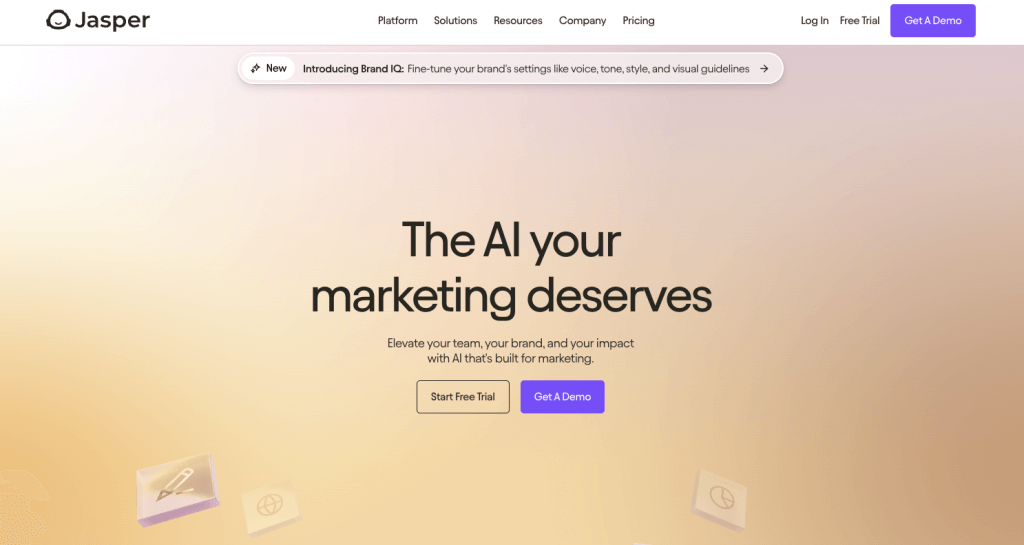
Key features:
- Content generation and idea inspiration. Jasper.ai can generate entire paragraphs or sections of text based on prompts, making it ideal for brainstorming and overcoming writer’s block. Users can input a brief idea, and the AI will expand on it, offering creative directions for the content.
- Tone and style customization. Jasper allows users to specify the tone and style they wish to convey, whether it’s friendly, professional, humorous, or formal. This feature is particularly useful for brands aiming to maintain a consistent voice across all content.
- SEO-focused writing. Jasper integrates with SEO tools like Surfer SEO, enabling users to optimize content for search engines. This helps create content that ranks well, driving more organic traffic to their sites.
- Content templates for marketing. Jasper.ai offers a wide range of pre-built templates for various marketing needs, such as email marketing, product descriptions, social media ads, and blog intros. These templates guide users through structured content creation.
Both Grammarly and Jasper.ai exemplify the capabilities of AI-powered writing assistants but cater to slightly different needs. Grammarly excels in ensuring correctness and clarity, while Jasper.ai shines in content generation and creative writing. Together, they provide a comprehensive suite of tools that can improve writing quality, creativity, and productivity across various content types and professional requirements.
Marketing automation tools
AI-driven marketing automation tools have transformed how companies manage campaigns, nurture leads, and engage customers. Marketo and HubSpot are two standout platforms that leverage AI to streamline marketing processes, providing businesses with advanced tools to connect more personally and effectively with their audiences. Here’s a look at how their AI capabilities can power your marketing strategy.
Marketo
Marketo, an Adobe company, has incorporated AI capabilities to improve marketing automation, especially in creating personalized and predictive campaigns. Explore some of its AI-driven features.
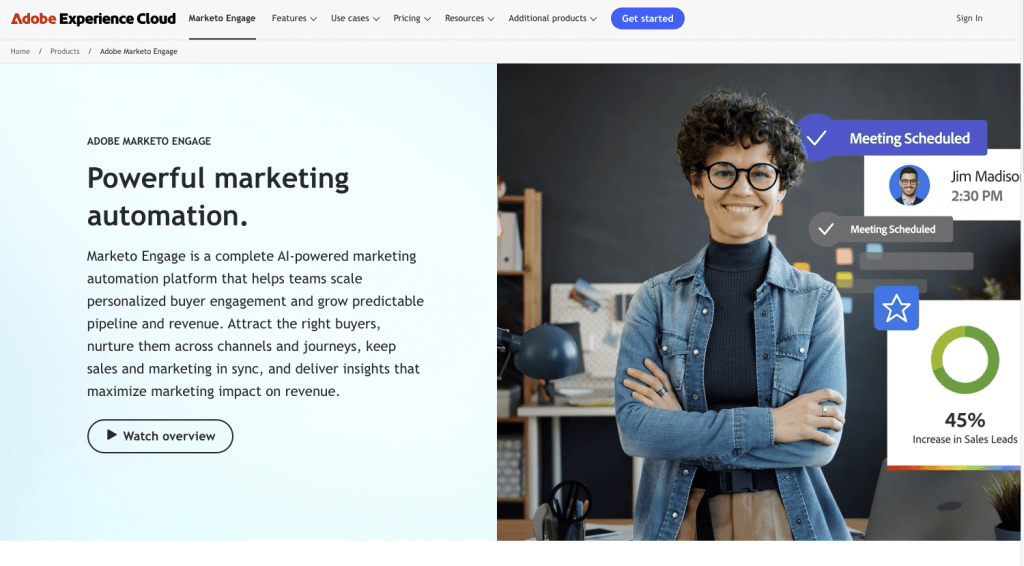
Key features:
- AI-powered content creation. With Marketo, it’s possible to generate personalized content for various channels, including emails, chatbots, and webinars.
- Personalization. Marketo enables users to deliver tailored experiences to customers through AI-driven dynamic content and chat interactions.
- Streamlined sales processes. You can optimize sales efficiency with AI-powered meeting scheduling and sales enablement tools.
- Data-driven insights. With Marketo’s AI, it’s possible to analyze customer data and obtain valuable insights for marketing and sales teams.
- Automated workflows. Marketo allows you to automate repetitive tasks, such as lead scoring and campaign management, to increase efficiency.
HubSpot
HubSpot’s AI-powered tools make it easier for marketers to attract, engage, and delight customers through personalized, data-driven strategies.
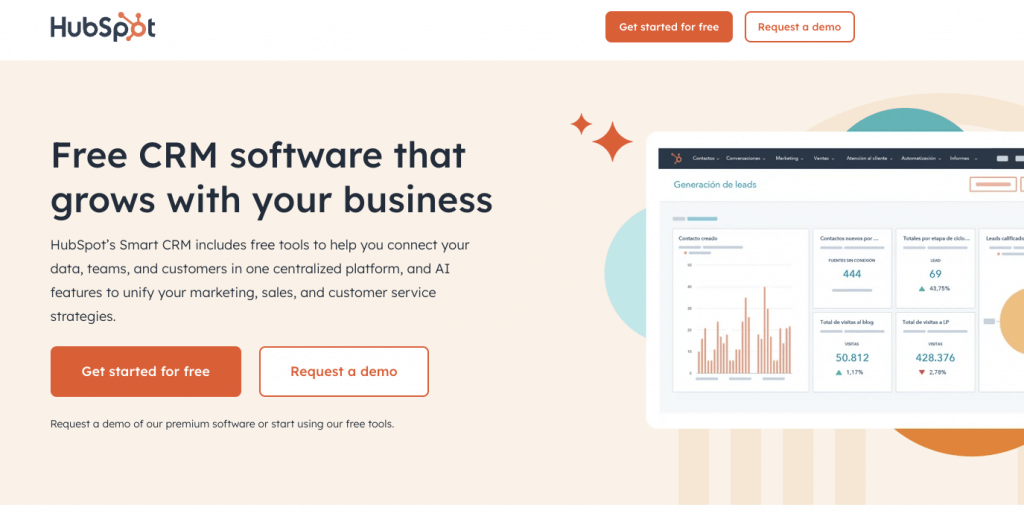
Key features:
- AI content generator. HubSpot can help with generating content for various platforms, including blogs, social media, and email marketing.
- Web builder assistant. This AI-powered tool simplifies website creation by automatically generating website layouts, content, and design elements. It can also help you build professional-looking websites without requiring extensive technical knowledge.
- AI reporting assistant. The AI reporting helper automates the process of data analysis and report generation. It can quickly generate insightful reports, identify trends, and help you make data-driven decisions.
AI-based customer service tools
Ensuring a smooth customer experience is key. Here, AI-powered customer service tools can offer more speedy responses while keeping the experience simple and satisfactory for the customers. Among the most popular AI tools in customer service are chatbots and virtual assistants. These tools ultimately transform how businesses engage with customers, offering 24/7 support, immediate responses, and personalized interactions.
Chatbots
Chatbots are AI-powered tools that interact with customers in real-time through text-based conversations. They’re capable of handling a wide range of customer inquiries, from basic FAQs to complex troubleshooting, and can work across websites, social media platforms, and messaging apps.

Explore how chatbots can help you improve customer service:
- 24/7 availability. Chatbots can provide around-the-clock support, ensuring customers can get answers at any time, without the need for human agents to be available.
- Instant response. Chatbots eliminate wait times by offering immediate responses to common questions, improving the overall customer experience.
- Handling repetitive tasks. Chatbots are ideal for managing repetitive tasks, such as answering frequently asked questions, processing simple transactions, or providing basic product information.
- Personalized interactions. Advanced chatbots can be integrated with customer data, enabling them to deliver personalized responses based on user history, preferences, and past interactions. This helps create a more tailored experience for each customer, which can increase satisfaction and loyalty.
Virtual assistants
While chatbots are great for straightforward interactions, virtual assistants go a step further by providing more advanced, conversational experiences. Virtual assistants are typically powered by more sophisticated AI, often including natural language processing (NLP) and machine learning capabilities, which allow them to understand and respond to more complex customer needs.

Here’s how virtual assistants can elevate customer service:
- Natural language understanding. Virtual assistants excel at understanding and processing natural language, making interactions feel more human-like. Customers can engage with virtual assistants using conversational speech or text, leading to smoother and more intuitive communication.
- Task management and multi-channel support. Virtual assistants can handle a variety of tasks, such as scheduling appointments, processing orders, sending reminders, and even managing customer accounts.
- Proactive assistance. Rather than waiting for customers to initiate contact, virtual assistants can proactively engage users with relevant information. For example, they can send reminders or offer product recommendations based on browsing history.
- Integration with business systems. Virtual assistants can be integrated with CRM systems, helpdesk software, and other business tools to provide deeper insights into customer needs. This integration allows them to access customer history, track issues, and offer tailored solutions based on previous interactions.
- Continuous learning. Virtual assistants can improve over time by learning from interactions and gaining new insights through machine learning. As they process more customer interactions, they become better at understanding context, handling complex queries, and offering accurate solutions.
Final thoughts on AI tools for business
There are many different components of a successful business that have to work well together. From analyzing data to presenting ideas and creating content, AI tools can improve business operations, allowing teams to work smarter and scale their efforts. By taking advantage of AI tools for business, you can potentially reduce costs, improve efficiency, and elevate your ability to connect with customers on a more personal level. As AI technology continues to evolve, it’ll open up new opportunities for innovation and growth across industries, further transforming the way we do business in the digital age.
If you’re curious about AI and want to explore how an AI-powered data visualization tool like Infogram can help you turn data into engaging charts in seconds, sign up and discover the possibilities!
Get data visualization tips every week:
New features, special offers, and exciting news about the world of data visualization.